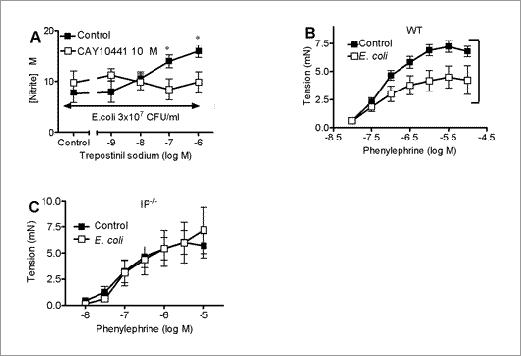033P Brighton
Winter Meeting December 2007 |
Role of prostaglandin I2 IP and PPAR beta receptors in the sensing of Gram negative bacteria
Laura Moreno1, Lucy K. Bailey1, Louise Harrington1, Mark Paul-Clark1, Timothy D. Warner2, Jane A. Mitchell1
1NHLI. Imperial College, London, United Kingdom, 2The William Harvey Research Institute, Barts and the London, Queen Mary’s School of Medicine and Dentistry, London, United Kingdom
Activation of vascular smooth muscle cells (VSMCs) and the subsequent induction of inflammatory genes including nitric oxide (NO) synthase (NOS) II, by bacteria are crucial events in the development of vascular hyporeactivity to contractile agents and septic shock (Cartwright et al., 2007). Prostaglandin I2 (PGI2) is a cardio-protective hormone released from endothelial cells, which acts via both cell surface PGI2 (IP) receptors and cytosolic PPARbeta nuclear receptors. PGI2 is increasingly recognised as an important immune-modulator hormone, however, the relative role of IP versus PPARbeta receptors in this function is unknown. Here we have investigated the role of IP receptors in the sensing of whole E. coli by vessels and VSMCs. Rat VSMCs were incubated for 24 hours with whole heat-killed E. coli (3x107 CFU/ml) in the presence or absence of drugs. NOSII activity was determined by the Griess reaction as the accumulation of nitrite in the culture medium. In separate experiments aortae from C57Bl6 (WT) or IP-/- mice (25-32g), killed by cervical dislocation, were incubated overnight with E. coli before contractile responses were measured in myographs (Cartwright et al., 2007). The PGI2 analogue, treprostinil sodium (TS, 1nM to 1 μM) increased the formation of NO by VSMCs stimulated with E. coli. This was blocked by pre-treatment with the IP antagonist CAY10441 (Figure 1A). In contrast, the selective PPARbeta agonist, GW0742 (1μM to 1mM) inhibited E. coli induced NOSII activity in VSMCs (control, 0±0; plus GW0742 100μM, 0±0; plus E. coli, 11.3±1.2; E. coli plus GW0742, 1.6±0.5 μM nitrite; n=9). E. coli induced hyporeactivity to phenylephrine in vessels from wild type (Figure 1B), but not IP-/- (Figure 1C) mice.

Figure 1 Effect of treprostinil sodium and CAY10441 (10μM) on NOSII activity in VSMC incubated with E. coli (3x107 CFU/ml), (A).Effect of E. coli (108 CFU/ml) on vascular responsiveness to phenylephrine in tissue from WT (B) or IP-/- (C) mice. All values represent the mean±SEM. n=5-9 and were analysed using one-way (A) or two-way (B and C) ANOVA. * denotes p<0.05.
These observations suggest that in blood vessels and in VSMCs, IP receptors mediate the sensing of E. coli. PPARbeta receptors in VSMCs appear to act oppositely by reducing the ability of E. coli to induced NOSII activity. These data identifies IP receptors as possible therapeutic targets for the treatment of Gram negative sepsis
Cartwright N. et al. (2007) Am J Respir Crit Care Med 175:595-603
L. Moreno is supported by a Marie Curie Intraeuropean Fellowship
|


